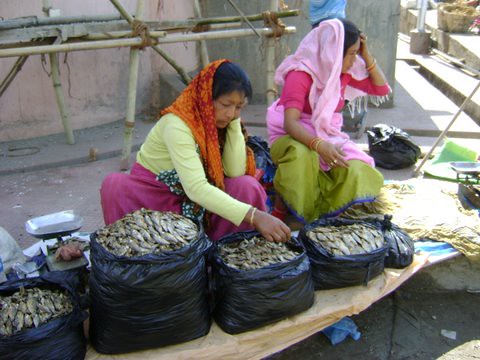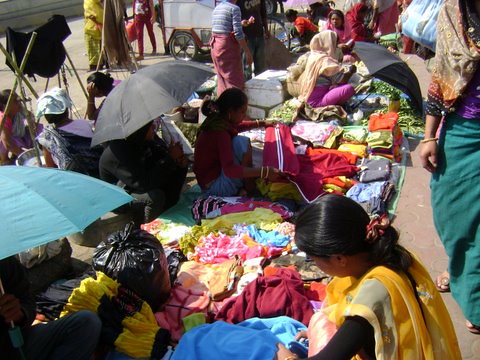Ima market of Imphal
Imphal: The Khwairamband Bazaar, Imphal, Manipur is a marketplace with peculiar smell, sweat, cacophony and busy movements of shoppers and as well the shopkeepers. There is hardly anyone who does not require visiting the market. Khwairamnand bazaar or the popular name Ima market or Nupi Keithel is the world’s only all-women marketplace and one of Imphal’s main tourist attractions. This is because the most important feature of the market is that 4000 odd shopkeepers are women representing the greater mobility and economic participation of Manipuri women.

Women vendors selling dry fish, a popular food in north east India
What is not sold in the Ima Market? One can easily find items ranging from food items such as fresh fruits and vegetables, meat, fish and dried fish to local herbs to clothes and woolens, and traditional costumes. Metal and bamboo items are also found in the shops. The market consists of two main sections -one where the vegetables, fruits and necessary items are sold and the other where the handloom product of the state is sold. Ima market displays local culture, tradition and biodiversity. Products sold here are mostly local products.
Origin of the market:
There is no clear indication of the beginning of the market. The earliest indication of barter system in Manipur can be traced during the reign of Meidingu Thangwai Ningthouba in 1805. Many markets were established during 1592-1652 in different places for business transaction. Researchers indicated that the Gazetteer of Manipur 1786 indicates that all the marketing of the country was conducted by women in open air and markets were mostly held in morning time. In between 1948-52, a proposal came from some local rich persons in connivance with the petty alien trades to demolish the existing shed. But women were not outnumbered and were successful in retaining it. Centre for Organisation Research & Education (CORE), Manipur, India in a report published in 2005 pointed out that ‘these Keithel as not just hubs of commerce, but also of information exchange and socio-political processes’. During lunch or break times women discuss socio political issues and this flow of information keep them aware and empowered. It won’t be wrong to say that the Nupi Lan or women’s upraising against the British in 1904 and 1939 were organized and conceived from the market places. Thus women shopkeepers here are not simply business women but are leading examples of leadership and revolutionist.

Women vendors busy with their customers
Recent developments:
The 3 (three) Markets in Khwairamband Bazar, namely Ima Market, Laxmi Bazar and Linthoinganbi Bazar constructed by the Imphal Municipal Council will replace the traditional sheds of the Ima market. This development is not beyond controversy. Starting from nomenclature of the three complexes, allotment of shops, feeling of discrimination etc will haunt the celebration for many women. Several indegenous bodies have objected the nomenclature of the three complexes terming it non representative of the culture and history of the land. Shops are allotted to ‘licensed’ vendors while some women said that an average of 300 single women and widows, mostly the widows whose husbands are killed in fake encounters join the market to earn their livelihood. Most of these women have no license. In such a situation there is risk that these women will lose their livelihood. Several bodies have demanded special allotment or reservation for their community women. Kabui community has demanded 200 shops while muslim community has demanded 9% allotments in the new complexes.

Part of the newly constructed building
Whatever the controversies, the market will remain a unique historic symbol of women empowerment and women’s leadership in economic development. This is something the policy makers of any country, regions can think of as a model for women empowerment and gender justice in the society.
This comment has been removed by the author.
ReplyDelete